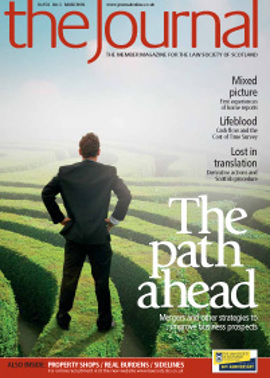Learning experience

Quite often the opportunity for learning lessons from a claim, or a complaint, is missed. Sometimes the circumstances of the claim are dismissed as unique; sometimes it is concluded that there is no way that the situation could have been avoided. While occasionally that may be a justified conclusion, more often than not it will be possible to derive some risk management benefit from reviewing the circumstances that resulted in the claim and analysing the underlying causes and contributory factors. Let’s consider an example.
Case study
Missives were concluded for a Mr and Mrs A for the purchase of a plot on which they intended to build their dream home. The missives were conditional on planning permission being obtained within six months.
The planning application was still under discussion when the six month period expired. No action was taken by or on behalf of Mr and Mrs A to rescind the missives and, accordingly, missives were concluded. Ultimately, planning permission was refused and, when they re-sold the plot, they incurred a substantial loss. Mr and Mrs A made a claim against their solicitor for their losses.
Possible causes
The brief summary of what happened makes it difficult to establish the true cause(s) of Mr and Mrs A’s claim. For the exercise to be effective, it would be necessary to know more about the facts and circumstances. Based on the brief synopsis, the cause(s) in this case could have been one or more of the following:
failure to communicate effectively so that the clients were made aware of:
- the meaning and implications of the missives condition;
- the action that required to be taken in different circumstances to ensure that their position was protected;
- the consequences of failure to take that action;
failure to diary the critical date(s) effectively with appropriate reminders to prompt (and allow time for) discussion with the clients ahead of the ultimate deadline;
failure to check the precise terms of the missives condition;
incorrect assumptions about:
- the nature/effect of the condition;
- who was responsible for taking the necessary action (client or solicitor).
“Getting the law wrong” accounts for a very small proportion of claims. The majority of claims (the case study concerning Mr and Mrs A is an example) arise from a failure in communications or in some aspect of management of the transaction (the file, the client, or timescales for example).
Preventing recurrence
The case study illustrates the range of risks that exist in even an apparently routine transaction. In addition to the drafting and other technical aspects of the transaction, there are the risks of reliance on one’s recollection of (or assumptions about) the precise terms of a missive condition, particularly after a period of months, or making the assumption that a client will understand the specific terms and implications of a missive condition, and the need for certain action to be taken timeously to protect their own interests.
A number of potential action points might be justified outcomes from review and analysis of the case of Mr and Mrs A. These may include:
targeted training;
amendment of the firm’s standard documents (terms of engagement or scoping letters);
possible introduction of a “sign-off letter” (issued at a key point in an engagement highlighting key dates/actions); introduction of relevant checklists to prompt consideration of key issues and critical dates;
file review or file audit to establish how colleagues are addressing critical date issues.
The preventive action plan should not be simply “All fee earners to ensure there is no repetition”, or “Avoid being negligent”. While the sentiment may be understandable, as a preventive action plan, it is not particularly helpful.
Analysis/action plans
Since November 2007, the Society’s Insurance Committee has been running an exercise to encourage practices to analyse claims and devise action plans to prevent recurrence. Practices are encouraged to respond to Marsh with a copy of their completed analyses/action plans.
No confidential information is passed to the Society.
An example of a completed analysis/action plan is reproduced below. It illustrates how the value of the exercise may be limited if the risk management actions are not clearly defined and measurable.
The format of the analysis/action plan is simple. It requires recording of basic facts about the case and the grounds of the claim. It then requires consideration of any contributory factors, which in turn assists the formulation of a practical preventive action plan/schedule.
Date of occurrence
Determining the date of occurrence
of an (alleged) error or omission is useful and informative. If it is recent, that may justify a different conclusion from circumstances where the error/ omission occurred decades ago when the practice’s activities, personnel and risk profile were completely different.
There can be a significant time lag between a mistake being made and a problem arising from that mistake and resulting in a claim. This is particularly true of certain types of work. A title boundary issue, for instance, may remain undetected and cause no difficulty for the client until resale, remortgage or redevelopment, at which time an examination of the title reveals a discrepancy between the title boundary and the occupational boundary.
Common denominators
Establishing the existence of possible common denominators or recurring factors can be extremely helpful in achieving the objective of improving the firm’s risk profile. A common theme might emerge, for instance, in terms of responsible fee earner (see the example analysis/action plan) or branch office. This may justify a review of the work of the particular fee earner, practice area or branch office to identify and address particular performance issues.
The potential common denominator might, alternatively, be client-related or related to the firm’s vetting or engagement processes. This finding might prompt a critical review of the firm’s processes, policies and procedures.
Preventive actions
A conclusion that a claim was caused wholly and exclusively by the incompetence of a particular colleague (see the example analysis/action plan), and that the departure of that colleague means that the risk has been fully addressed, may be a justified conclusion. However, it may be that the apparent responsibility and alleged incompetence of the former colleague masks other factors (a lack of supervision or a requirement for training, for instance) which, if not addressed, could continue to expose the firm to future claims.
Responsibility
Action points require to be made the responsibility of a particular individual, otherwise there is a real risk that no one will take any action. Assigning responsibility to “all fee earners” as in the example below, or to “all trust & executry fee earners”, risks everyone assuming that someone else is taking responsibility – with the result that no one takes any action at all.
Completion and review dates
As with any business goal, establishing a schedule for implementation improves the prospect of the action plan being
fully and successfully implemented. In the absence of a schedule for implementation, or any ongoing monitoring or review of progress there is a possibility that, for example, a training initiative fails to reach recent recruits, or that a change in the firm’s procedures is operated inconsistently from one practice area or team to another. Such gaps or inconsistencies may only emerge when, to everyone’s frustration, a subsequent claim demonstrates that an otherwise sound action plan has failed to achieve its objectives.
Essential goal
Considerable efforts have been made across the profession to enhance risk awareness and risk controls over recent years. As a result of those efforts, many practices have succeeded in maintaining a consistently claims-free record over an extended period. Other practices can take satisfaction from the fact that their efforts have kept claims to a minimum. Avoiding repetition of an error or omission must be one of the essential risk management goals of all law firms, and this is achievable by adopting a methodical and action-based approach to learning from claims.
In this issue
- Corporate governance in family businesses
- Que será, será….
- A matter of form in administrations
- You may have to be mad to work here
- No standing still
- A new regime for financial advice
- United we stand?
- Watch your local trend
- Cash flow: the five essentials
- Secure our future
- Opportunity lost?
- The kilt doesn't quite fit
- We can work it out
- Asset in recovery
- Law reform update
- Be your own money saving expert
- Skeleton crew
- Ask Ash
- Only half a step
- Learning experience
- Too late, too late?
- Variations and the three year rule
- Fruits of their labours
- Death of a claim
- All part of the game
- Scottish Solicitors' Discipline Tribunal
- Website review
- Book reviews
- Just whistle while you work
- Performance review






